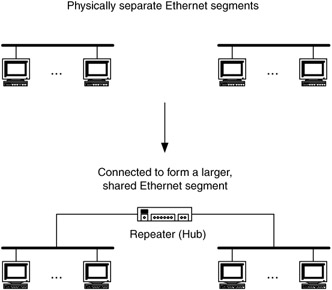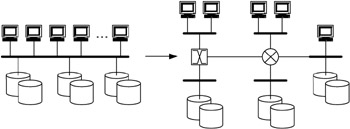11.4 Shared Medium (No Interconnection)
11.4 Shared Medium (No Interconnection)
A shared-medium mechanism is when all devices on the network (or subnetwork) share the same physical medium. When a shared-medium mechanism is applied to areas of a network design, the areas are combined to form a larger version of an area network. Figure 11.4 shows an example of this.

Figure 11.4: Interconnecting multiple Ethernet segments using a shared-medium mechanism.
In Figure 11.4, Ethernet has been chosen for two areas of a network design. By making these areas, each of which has its own Ethernet network, shared medium, we have combined them into one larger Ethernet network. This is done by directly combining the networks through physical connections or repeaters. The result is that the combined areas all share a common broadcast domain at the link layer and a common IP addressing structure at the network layer.
Although this is the simplest interconnection mechanism, it has major trade-offs, primarily the lack of scalability. As the numbers of devices on a shared-medium network grows, so does the overhead associated with multicast, address-resolution, and network-layer functions. This overhead can degrade network performance and cause congestion that will make the network unusable. As a result, hierarchy forms to isolate parts of the network from each other. When does this hierarchy form, and when should we plan to expect or provide hierarchy in the network? To answer these questions, we need to consider scalability, flow model optimization, and external connectivity.
In Chapter 10, we looked at scaling the network based on the growth in users, applications, and devices. Scaling was achieved by selecting candidate technologies that could either handle the expected growth in capacity or had planned upgrades to meet the expected increase in capacity by the time it was expected. Another way to meet growth expectations is to plan for hierarchy in the design.
Planned hierarchy is integrating into the network design methods to isolate and hide networks and their traffic from one another. Planned hierarchy can be accomplished over time by adding new networks to the design or segmenting existing networks, as in Figure 11.5.

Figure 11.5: Planning hierarchy in the network design.
When hierarchy is added to a shared-medium network, the shared medium is segmented and interconnected by bridges, routers, switches, or hybrid devices. The guidelines for capacity planning developed earlier for scaling networks can be applied here, with slight modifications, to show when hierarchy needs to be introduced into the shared-medium network:
-
When the maximum (peak) rate for expected traffic flows on a shared-medium network approaches 80% of the capacity for the technology used in that network
-
When the sustained data rate for expected traffic flows on a shared-medium network approaches 60% of the capacity for the technology used in that network
In these guidelines, traffic is the statistical sum of all application, user, and device information flows over that network. This is determined by either sampling the flows over the network (if there are existing networks or testbed networks where this can be done); using existing information from traffic studies; or estimating the traffic based on each application's peak and/or sustained data rates, percentage utilization of that application on the network, and number of simultaneous sessions of that application.
Given that many of today's applications and devices can easily reach the maximum capacity of many network technologies, including Fast Ethernet and ATM/OC-3c, planning to introduce an interconnection mechanism to segment a shared-medium network is worthwhile. This is true even when the peak and sustained data rates for applications on that network are low relative to the capacity of the shared-medium network.
A requirement for a high degree of interconnectivity is also an indication of the need for an interconnection mechanism. The higher the degree of interconnectivity (the degree of connections within the network at different levels in the design, to provide greater performance through parts of the network) is within a network, the greater is the need for an interconnection mechanism that can rapidly reroute traffic. When we apply interconnection mechanisms to the design, we will use degrees of interconnectivity to determine when and where to apply them.
A shared-medium mechanism is typically not optimal for the flow models described in Chapter 4. When client-server, hierarchical client-server, or distributed-computing flow models are indicated in the design, we should automatically consider an interconnection mechanism for that part of the design. As discussed in Chapter 4, these flow models have characteristics that are optimized by creating a separate path for each flow.
When external connectivity is expected, an interconnection mechanism must be added to the design. When connectivity is to the Internet, the interconnection mechanism must be IP routing or a protocol gateway.
Interconnection mechanisms are closely tied to security, administration, and network management. These functions are often co-resident with interconnection mechanisms. As we will see later in this chapter, the mechanisms selected for interconnecting networks will play a role in how security and network management are implemented.
EAN: 2147483647
Pages: 161